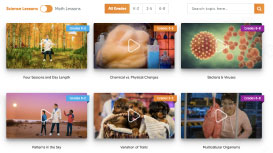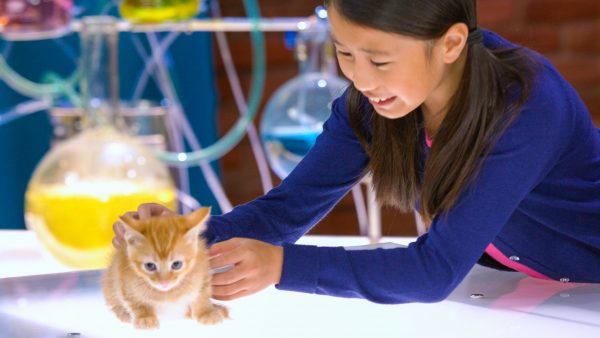Definition Of Non-living Things
Non-living things do not grow, take in nutrients, or reproduce. For example, a book or a lamp.
View Lesson on Living vs. Non-Living Things
Become a member to get full access to our entire library of learning videos, reading material, quiz games, simple DIY activities & more.
Become a member to get full access to our entire library of learning videos, quiz games, & more.
Plans & Pricingto watch this full video.

Access All Videos
and Lessons, No Limits.
Access All Videos

No credit card required,
takes 7 sec to signup.
No card required

Ready-to-go lessons
that save you time.
Ready-to-go lessons
If you are on a school computer or network, ask your tech person to whitelist these URLs:
*.wistia.com, fast.wistia.com, fast.wistia.net, embedwistia-a.akamaihd.net
Sometimes a simple refresh solves this issue. If you need further help, contact us.
Living vs. Non-Living Things
Fun Facts
- A rock does not grow.
- A robot does not eat food or drink water.
- A camera does not reproduce.
Why Do We Need To Know About Definition Of Non-living Things
Learning about things that aren’t alive helps us see how important they are in our daily lives and in different jobs. Things like books, desks, and chairs are really important in schools. These items are connected to jobs in teaching, designing rooms, and making furniture.
Knowing about things that aren’t alive, like robots that don’t need to eat or have babies, can lead to jobs in robot making, engineering, and technology. This knowledge is important in many areas, like health care and movies, showing us how non-living things are useful in many kinds of work.
Frequently Asked Questions
Check out the Full Lesson on Living vs. Non-Living Things
In this lesson, we learn that:
- Living things grow, take in nutrients and reproduce.
- Non-living things don't do those three things.
- There are many living and non-living things all around us.
Related Topics
- Atom Definition
- Balanced Force Definition
- Batteries Definition
- Biochemistry Definition
- Biodiversity Definition
- Camouflage Definition
- Carbon Dioxide Definition
- Carnivore Definition
- Cellular Respiration Definition
- Circuit Definition
- Collision Definition
- Convergent Boundary Definition
- Corona Definition
- Definition Of Experiment
- Definition Of Living Things
- Definition Of Non-living Things
- Energy Conversion Definition
- Energy Transfer Definition
- Engineer Definition
- Environment Definition
- Freezing Definition
- Gas Definition
- Gas Definition
- Germination Definition
- Heating And Cooling Definition
- Igneous Rock Definition
- Information Transfer Definition
- Insulator Definition
- Landform Definition
- Light Source Definition
- Liquid Definition
- Magma Definition
- Mass Definition
- Matter Definition
- Ocean Current Definition
- Pollinator Definition
- Properties Of Matter Definition
- Reproduction Definition
- River Definition
- Seismologist Definition
- Soil Definition
- Tectonic Plates Definition
- Tissue Definition
- Trait Definition
- Virus Definition
- Water Quality Definition
- Weather Definition
- Weather Front Definition
Start a Free Trial Today. Get a $5 Amazon Gift Card!
Teachers! Start a free trial & we'll send your gift card within 1 day. Only cards left. Try it now.
Select Grade
Select Subject
This email is associated with a Science Kit subscription. Kit subscriptions are managed on this separate page: Manage Subscription

-
Download InvoiceScience & Math$/yr
-
Download InvoiceScience Only$/yr

access all lessons
• No credit card required •
"My students loved the videos. I started the video subscription in May and used them as a review before the state test, which I know contributed to 100% of my class passing the state test."
Rhonda Fox 4th Grade Teacher, Ocala, Florida
• No credit card required •
"My students loved the videos. I started the video subscription in May and used them as a review before the state test, which I know contributed to 100% of my class passing the state test."
Rhonda Fox 4th Grade Teacher, Ocala, Florida
• No credit card required •
Already a member? Sign In
* no credit card required *

* no credit card required *
* no credit card required *


no credit card required
Skip, I will use a 3 day free trial
Enjoy your free 30 days trial
-
Unlimited access to our full library
of videos & lessons for grades K-5. -
You won’t be billed unless you keep your
account open past your 14-day free trial. -
You can cancel anytime in 1 click on the
manage account page or by emailing us.
-
Unlimited access to our full library of videos & lessons for grades K-5.
-
You won't be billed unless you keep your account open past 14 days.
-
You can cancel anytime in 1-click on the manage account page.
Cancel anytime in 1-click on the manage account page before the trial ends and you won't be charged.
Otherwise you will pay just $10 CAD/month for the service as long as your account is open.
Cancel anytime on the manage account page in 1-click and you won't be charged.
Otherwise you will pay $10 CAD/month for the service as long as your account is open.
We just sent you a confirmation email. Enjoy!
DoneWe use cookies to make your experience with this site better. By using this site you agree to our use of cookies. Click "Decline" to delete and block any non-essential cookies for this site on this specific property, device, and browser. Please read our privacy policy for more information on the cookies we use.Learn More
We use cookies to improve your experience. By using this site, you agree to our use of cookies. Click "Decline" to block non-essential cookies. See our privacy policy for details.Learn More



























































































































